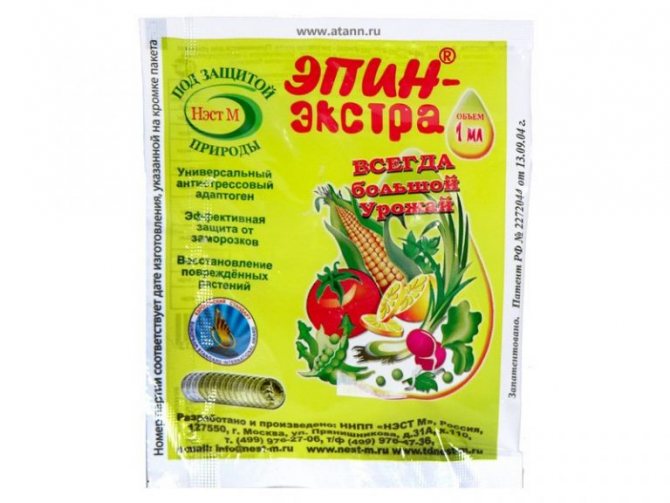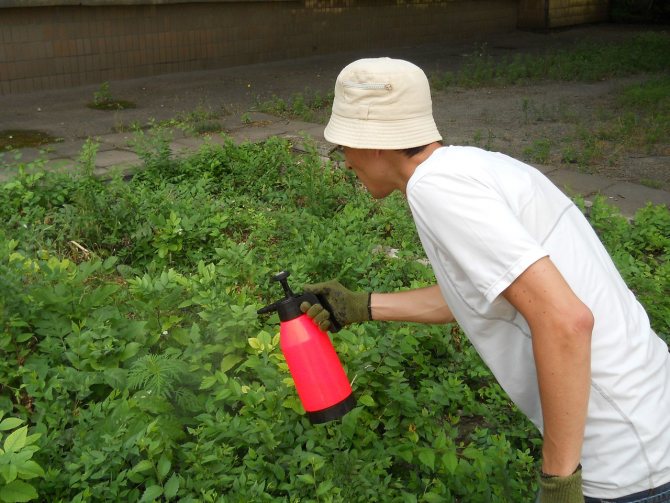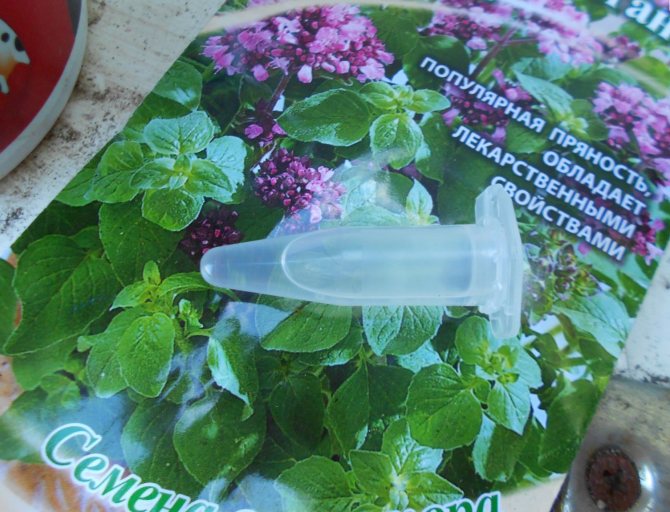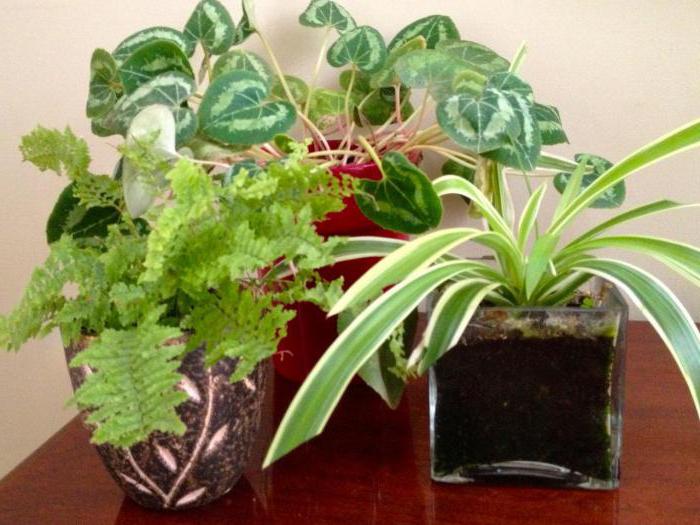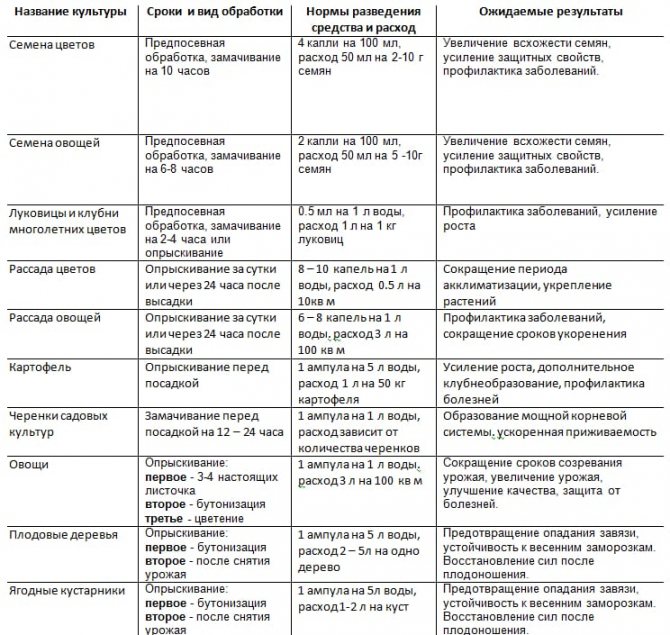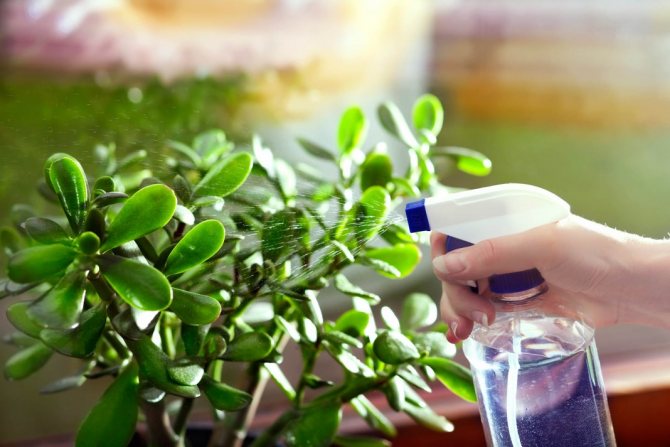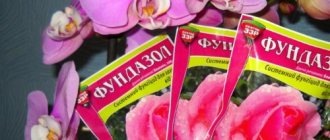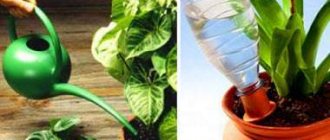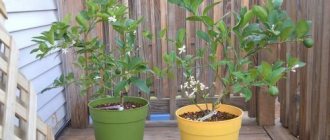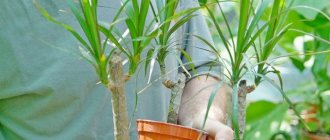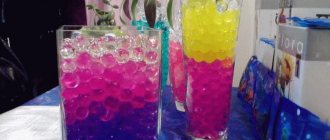Fertilizers
Over the past years, flower shops have delighted us with the variety of their assortment and rarely can anyone refrain from buying a delightfully flowering plant. Unfortunately, after a while, our new pet loses its former beauty and begins to wither. It is almost impossible to return it to growth and flowering by simple watering. In such cases, the use of immunomodulators is recommended, but often growers do not understand how to use them. In this article, you will learn what phytohormones are for and why Epin is important for indoor plants.
Composition and purpose of the drug
The basis of Epin is a phytohormone, it is an active substance, ensures its effectiveness and determines the use of the agent. Experienced gardeners and flower growers use the drug in different ways.
For plants
- Soaking cuttings before rooting.
- Foliar dressing (spraying) in stressful situations.
Gardeners often ask - to water or spray with Epin? It makes no sense to water with Epin's solution, because its assimilation occurs by suction by the sheet plate.
For seeds
The seeds are soaked in the working solution for 4-6 hours. Such processing:
- Accelerates germination.
- Increases the percentage of germination.
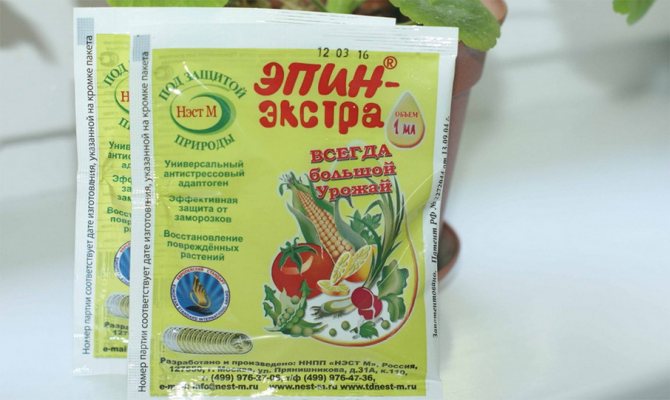
Description of the drug
Epin (epibrassinolide) is an artificial analogue of a natural plant biostimulant. It belongs to steroid phytohormones, thanks to which the normal functioning of the plant's immune system is maintained, especially in stressful situations (during drought, frost, floods, rainstorms and other negative environmental influences). As a stress adaptogen, Epin is characterized by active growth stimulation. When treated with this preparation, the yield increases by more than 15%, the ripening of fruits is accelerated.
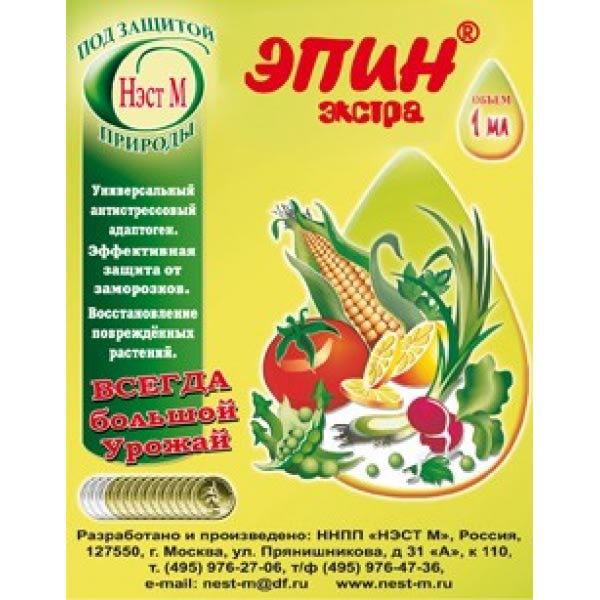

The active ingredient of the drug is epibrassinolide, due to which all biological processes in the plant are activated, contributing to its recovery. They are used both for spraying plants and for processing seeds for better germination.
Advantages and disadvantages of Epin
The pros and cons of the funds are shown in the table:
| Benefits | disadvantages |
| It is quickly absorbed and transported throughout the plant. | Unstable, decomposes in the light. |
| Accelerates metabolism. | There are practically no macro- and microelements. |
| Activates protective functions, stress resistance. | To prepare a solution, you need pure water with a neutral or slightly acidic reaction. |
| Eco-friendly, safe for humans, animals, plants. | |
| Does not accumulate in the soil. |
Precautions
One of the most effective biological growth regulators today is Epin Extra. Application for indoor plants should be carried out using personal protective equipment. If, when spraying, a working solution gets on your hands or face, wash them thoroughly with warm water and soap, and rinse your mouth well. If the working solution suddenly gets into the digestive tract and causes poisoning, you should immediately consult a doctor.
Used ampoules are not recommended to be immediately disposed of in a landfill.They need to be washed with a solution of ordinary baking soda, rinsed under running water and only then thrown away.
Epin's application
The product is sold in ampoules of 1, 2, 50, 1000 ml. After opening, the stimulant is stored in a dark place for no more than 48 hours.
Preparation of working solution
Rules:
- Use settled water at room temperature 22-24 ° C.
- For the most effective action, the drug is diluted in slightly acidified water (3-4 crystals of citric acid per liter).
- Mix thoroughly.
- You need to use the solution within 2 days.
- Kept in the dark.


Soak
The table shows the data on the procedure time and concentration.
| An object | Working solution | Time |
| Vegetable seeds | 1-2 drops per 100 ml | 4-6 hours |
| Cuttings | 1 ml per 2 l | 1 day, before rooting |
| Seeds of flowers and ornamental plants | 4 drops per 100 ml | 8-10 hours |
| Flower bulbs | 1 ml per 2 l | 2 days, before boarding |
Spraying healthy plants and in case of stress and disease
Vegetative plants are sprayed with a stimulant in the morning or evening. The solution is prepared from 1 ml of the drug and 5 liters of water. The active ingredient of the product is absorbed by plants within 2-3 days. It is recommended to spray several hours before watering is supposed.
The phases of plant life and the use of Epin are shown in the table.
| Culture | Stage | Processing frequency (time) |
| Potatoes | Tubers | 1 (one day before boarding) |
| Bud formation, beginning of flowering | 2 every 7 days | |
| Vegetables, flowers | Seedlings | 2-3 (with an interval of 10 days) |
| Before diving / landing in the ground | 24 hours before or immediately after manipulation | |
| Fruit trees and shrubs | First leaves | 1 |
| beginning of budding | 2 (in 20 days) | |
| Onion sets | 4-5 leaf phase | 1 |
| All cultures | Under unfavorable growing conditions (low temperatures, threat of disease, drought, etc.) | Every 7-10 days until recovery |
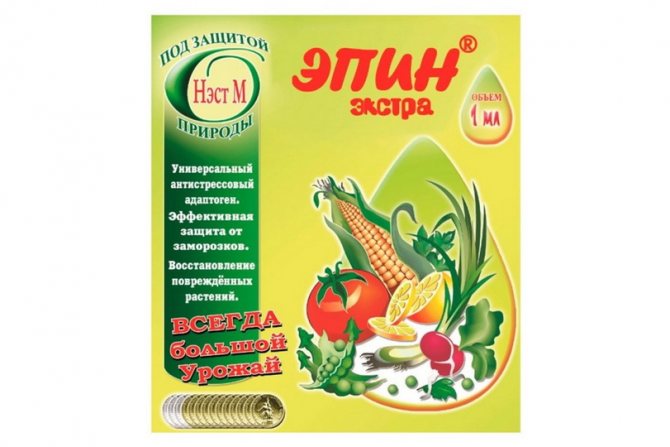

For plant fertilization
The use of Epin is useful for most crops. All manipulations with plants will be less painful if, before or after exposure, they are treated with a solution of the agent.
The use of the drug helps to neutralize harmful and hazardous substances in the soil, increases soil fertility and improves its structure.
Epin extends the life of cut flowers. It is enough to drop 2-3 drops into a vase, and roses will stand in a bouquet twice as long!
Biological stimulant properties
Using the Epin Growth Regulator allows you to achieve the following:
- accelerating the germination of planting material and plant growth;
- increasing the duration of the flowering period;
- increasing the plant's resistance to negative environmental factors, as well as accelerating the survival rate during transplantation;
- increasing plant resistance to various fungal and viral diseases;
- increasing the productivity of vegetable and fruit crops.
If the application for indoor plants "Epin Extra" is carried out, watering can be done less often. It has good compatibility with any mineral fertilizers and fertilizers, so they can be combined to achieve the best results.
Application for different crops
The stimulant is used in different ways in different crops.
Tomatoes
| Solution concentration | Application | Number of treatments |
| 1 drop per 200 ml | Soak seeds for 2 hours before planting | 1 |
| 1 ml for 5 liters of water | Spray when bud is formed and when the first flower opens | 2 |
Peppers and eggplants
| Norm | Application | Number of treatments |
| 1 drop per 200 ml | Soak seeds for 2-3 hours before sowing | 1 |
Pumpkin crops
Cucumber, pumpkin, vegetable marrow.
| Ratio | Using | Processing |
| 1 drop per 100 ml | Soak seeds for 2 hours before planting | 1 |
| 1 ml for 5 l | Spraying plants with two or three leaves and buds. | 2 |


Strawberry
| Norm | Application | Number of treatments |
| 1 drop per liter | Soak rosettes in solution for 12 hours before rooting | 1 |
| 1 ml for 5 l | Spray the plants one week after planting | 1 |
| After harvest and in spring, over young leaves and buds | 2 | |
| 1 ml per 10 l | Spray at the end of October | 1 |
Biostimulant for flowers
The methods of use and concentration for ornamental plants are shown in the table.
| Appointment | The number of drops of solution per 100 ml | Frequency | Period |
| Dealing with stress | 7 | Processing once a week | Within a month |
| Stimulation of growth and flowering | 14 | Three times with an interval of 7 days, not more often | The end of March early October |
| Vegetative propagation | Spray the plant 24 hours before picking, transplanting, dividing a bush, etc. |
General tips and tricks for working with Epin solution for indoor plants. Application
Note. Plants should be treated with the growth regulator "Epin" in products that provide protection for the body and respiratory tract.
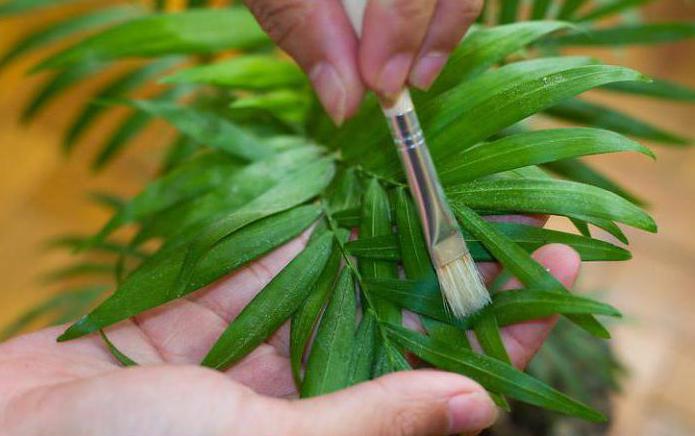

To keep everything going well, follow these tips and tricks:
- Do not smoke, drink or eat while spraying.
- After completing work, thoroughly wash your hands and face, and rinse your mouth.
- The biostimulant must not be stored in the immediate vicinity of medicinal products, as well as in places accessible to children and pets.
- Keep phytohormone ampoules away from open fire, as it is dangerous for the product.
If you use Epin for indoor plants, the use of which allows you to significantly accelerate the process of flower growth, it is forbidden to mix it with any other means intended for the care of flowers. Because it can cause a chemical reaction.
Security measures
Epin belongs to low-toxic substances, that is, it is practically harmless if used correctly and for its intended purpose. When working with him, take the following measures:
- Use a special container for the solution.
- Do not spray plants in a residential area. Better to do it outdoors.
- Protect your hands with gloves, your face with a gauze bandage.
- While working with the drug, you must not smoke, drink or eat.
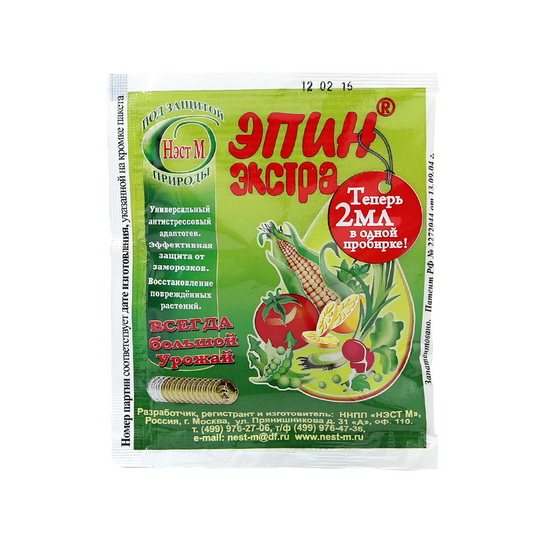

Important tips when using Epin
The safety rules when using this product are the same as when using fertilizers or poisons.:
- It is necessary to prepare the solution in a special container. Avoid contact with exposed skin.
- With extreme caution, you need to use the product if you are prone to allergies. In this case, you cannot do without a respirator.
When using the solution, you need to keep in mind that this is not a panacea and should not be abused.
Reviews of gardeners say that it is imperative to use "Epin-extra" if your seedlings are weak, the seeds do not grow well, the plants do not take root well. At the same time, it is not necessary to drastically increase the number of treatments. Crops can give too much growth, and there will be no strength left for flowering or fruiting.
Epin's price and where to buy
You can buy a stimulant in shops for summer residents or flower lovers. The product is sold in ampoules with a capacity of 1, 2, 50 or 1000 ml, which are placed in a bag. If Epin will be used only for indoor plants and you are planning one treatment, then the optimal volume is 1 or 2 ml, since the solution is stored after opening the ampoule for only 2 days.
The purchase will cost between 10-35 rubles and depends on the volume.
Epin is a useful drug, it has no analogues. Domestic scientists have developed and proved its effectiveness. The tool is widely used in China, the grain yield increases by 10-12%. Epin is safe for people and animals, does not harm nature, does not pollute water and air.
Growth regulator composition
The main active ingredient of this biostimulant is concentrated epibrassinolide, developed using modern technologies. Despite the fact that the substance is synthetic, it is nevertheless completely safe for flowers. It poses no threat.
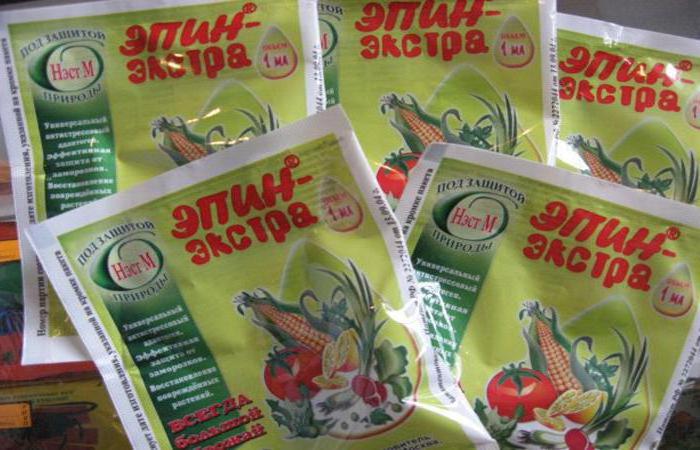

"Epin" for indoor plants, the use of which makes the flower healthier and stronger, is an alcohol solution. It is worth noting that the phytohormone for some time completely disappeared from sale due to the large number of counterfeits, but production was resumed in 2003. And the tool has received a new name "Epin Extra". In addition to the name, the chemical formula of epibrassinolide has also changed. The substance has become more effective, due to which its concentration in the growth regulator has been reduced. Also, shampoo was added to the preparation, thanks to which the growth hormone is better retained on the leaves. "Epin" (instructions for use for indoor plants comes with the product) is produced using microbiological technologies based on the use of microbiological microorganisms and their metabolic products.
Why do indoor flowers need growth accelerators
Strong strong flowers growing in apartments saturate the air with oxygen, delight the eye with lush flowering and their beautiful decorative appearance. However, there are a number of factors that undermine the "health" of green handsome men:
- the wrong place for them in the apartment;
- a large amount of harmful substances in the surrounding atmosphere;
- too frequent or too infrequent watering;
- a strong effect on the vegetative mass of ultraviolet rays;
- high noise level;
- other negative reasons.
In such conditions, the flowers will develop poorly, bloom sluggishly (or they will stop throwing flower stalks altogether). In this situation, various bioregulators that stimulate the growth and flowering of plants can save the day.
Phytohormone preparations, which include epin extra, stimulate the growth of home flowers and are necessary:
- in order for the plants to be able to prepare for winter "hibernation", or to be activated at the beginning of the next season;
- to give an impetus to all parts of flowers - aboveground and underground - to the beginning of growth;
- as an aid in recovery from adverse conditions in which the flower was placed.
The drug, which is described in the article, stimulates the growth of the vegetative mass, the root system, the development of peduncles. The main substance in its composition is epibrassinolide, which is a natural or artificially produced hormone. It is it that helps green pets grow faster and bloom luxuriantly. The phytopreparation contains a large amount of alcohol, which does not disappear immediately after use. But after a few hours, its smell will disappear, and the well-foaming solution of epin will quickly begin to be absorbed by the root system of flowers.
Rooting cuttings
For good rooting of cuttings, soaking is applied before planting in greenhouses. In the evening, immerse three centimeters in the solution. Leave until morning. Subsequent soaks are carried out in a new solution, the used one is already unusable. Thanks to the drug, the root system is actively developing. It has a positive effect on not lignified green cuttings, taking into account the cutting time. The phytohormone accelerates rooting by thirty percent.
Cut cuttings of hard-to-root shrubs and flowers are placed in a container with a stimulant for three to five hours. After impregnation, they are planted in prepared moist soil. Covered with foil to prevent overdrying and excess moisture evaporation. After the leaves appear, spray every fourteen days until well rooted.
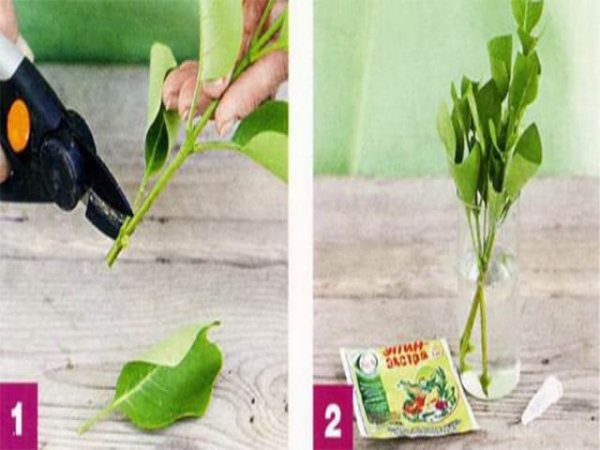

The second method involves direct processing of the mother plant before the cuttings procedure.Processing is carried out with a 1% solution in the evening. Further manipulations are identical.
Possibilities of the drug when spraying
- With a long absence of watering, it enhances the ability of the root system to extract water from the soil;
- With waterlogging, it increases the volume of evaporation from the sheet plate;
- With a lack of illumination, it accelerates the formation of chlorophyll;
- In case of metabolic disorders, it activates the protective properties of the plant cell;
- At high temperatures, it increases the formation of special proteins to relieve the "shock" of the plant;
- Promotes long and abundant flowering;
- Increases the immune resistance of flowers to diseases;
- Reduces the impact of stressful situations on the plant.
Preparing the finished solution
To prepare the active composition, it is required to dissolve the Epin ampoule in cool or moderately warm water. For this, gardeners often use ordinary tap water. And this is their main mistake. Tap water and untreated water contain large proportions of alkali harmful to crops. The chemical reaction of alkaline compounds and the active bio-substance epibrassinolide significantly reduces the effectiveness of the latter.
For the preparation of the working composition, it is recommended to use only water purified from alkali. It can be melted, settled or thoroughly boiled water.
There is another method for neutralizing alkali. Before mixing the main ingredients into the prepared water, you need to add a few crystals of powdered citric acid. After thoroughly dissolving citric acid, Epin can already be added to the water.


Operating principle
Epin is designed as an adaptive agent. But it is quite suitable for preventive measures or as root feeding.
It helps to increase the protective functions of the body and prevents the process of exhaustion. Since it replenishes internal reserves, which contributes to the rapid achievement of the necessary phase of the life cycle for normal development.
During the period of rooting of cuttings or flowering of root crops, a different effect will be achieved. The active substance strengthens it. Replenishes internal stocks or makes more rational use of internal reserves, opportunities.
Since the sprouts do not yet have a self-sufficient immune system, it will take time to defend themselves first. And only then to increase strength, stabilize.
Epin is actively used not only for garden crops or sprouts. It is also used for garden and decorative flowers. Any stressful situation will not threaten the plant.
Fertilization is especially useful on soils that are classified as unproductive for cultivation and high yields. At the same time, there is a decrease in monetary investments in agricultural chemistry.
The principle of action is soft. More like a condiment than a biostimulant. His task is to make the plant work, not the soil for seedlings. By provoking him to work for himself.
Need to know! Epin is suitable as a top dressing, a preventive substance for very delicate plants: orchids, azaleas. Exotic plants absorb it perfectly. It prevents Venus shoes, exotics, Cattleyas, Vandas and other "sissies" from feeling bad under unexpected or planned stresses (transplantation, pests, temperature changes, etc.).
For what and in what cases are they used?
Use the product if you want to achieve the beginning of flowering, to improve the decorative qualities of flowers. Protect indoor plantings in stressful situations, pest infestations, against the background of unfavorable growing conditions.


Application cases:
- transplanting young, adult plants, seedlings, children;
- moving, adaptation to a new place;
- cooling, overheating;
- before and after the growing season;
- weak, excessive lighting;
- underfilling, overflow;
- onset, development of diseases;
- harmful environment - dust, lack of ventilation, cigarette smoke.
Woody and shrubby, conifers
In the spring, tree and shrub seedlings are planted. The ecological solution is applied after disembarkation. There are ten liters of liquid per milliliter of substance. Average volume per six tree seedlings, seven shrubs. It is repeated during the period of bud setting, after flowering. In summer, the rates of treatments are identical, but the dosage is doubled.
The grafted plants can be processed after the scion has rooted. A mixture of a milliliter of the drug and two liters of water is required.
Spraying in greenhouses
For greenhouse plants, Epin can be useful as an antifungal agent mixed with fungicides. The only condition is not to spray during the day, in sunlight. Active substances lose their strength under the influence of ultraviolet radiation. The best time for Epin treatment is evening, when the sun disappears over the horizon.


Carry out processing according to the already familiar scheme:
- Seeds.
- Phase 2 of the leaves.
- Picking.
- Before flowering.
- During fruit setting.
Epin's concentration - according to the instructions.
Important! You can't water with Epin. Rather, it will not be beneficial, since the active substance is not absorbed by the root system. It is used only for foliar spraying.
Florist reviews
As mentioned earlier, one of the most effective biostimulants is Epin for indoor plants. Reviews of experienced flower growers engaged in flower cultivation fully confirm this. Regular treatment of plants with this tool allows you to increase the immunity of plants, as a result of which they are much less likely to get sick. In addition, flowers are less stressed during transplanting, especially during winter.


Many growers can reduce the amount of watering and increase the resistance of plants to negative environmental factors. If the pots of flowers are on the windows, then they will not be afraid of either drafts, or heat from heating elements, or too dry air. In addition, this growth regulator contributes to the rejuvenation of plants, so with its help it is possible to bring back to life even those plants whose chance of survival is rather low.
Related considerations
Epin gives excellent results in Russia and China, but the West stubbornly ignores him. This circumstance is used in antiepine propaganda, since there is nothing more to say against it. But to write off epinophobia for Russophobia and sanctions means scooping up the foam, not figuring out where it comes from.
They say that in the West, epin is simply not needed, there, they say, agricultural technology is so established that the plants are always good. Is the weather okay too? Frost, abnormal heat, dim light from air pollution do not happen? By the way, in the West, they use epin on the sly, as they buy other Russian products, from which there will be a profit. Everyone's heard of rocket motors and feed grains, but that's just the tip of the iceberg. As for epin, have you seen orchid flowers in mini vases in souvenir, gift and flower shops? They stand in their original packaging for up to a year (with a guarantee), because epin extra is in water.
In agriculture, the West is afraid of Epin for other reasons. Epin is, without exaggeration, the first swallow of a new era in food production. This is a bold statement, but let us remember and compare: the Internet and mobile communications were published simultaneously, in the mid-70s, only 4 decades ago. The first mobile phone for general sale weighed 14.5 kg and lasted 4 hours on a single charge; it had to be carried in a shoulder bag. A megabyte of traffic at a speed of 4800 bps (!) On the initial Internet cost $ 6. And then science fiction writers did not write about search engines, Internet media, Internet banking, smartphones and tablets.
According to the UN food organization, three-quarters of the world's population is now undernourished. In countries with developed agriculture, colossal money is made on this; drug mafia and arms dealers never dreamed of such a sweet dream. By the way, some of the harvest from leading producers is still systematically destroyed in order to maintain market prices. What is hidden from the general public in the most clever and brutal ways.
The widespread use of mild phytohormones will not only increase the productivity of existing sown areas, but also introduce many lands that are now considered infertile into agricultural circulation, which will help solve the global food problem.
In China, this is no longer a plan, but a really operating system. This is what scares both agribusiness dealers and the entire ruling elite. After all, they will then have to say goodbye to huge profits, revise land cadastres and the entire land use procedure. How to approach the tangle of problems arising at the same time, in the ossified, cleaner society of the former USSR, the society of the Great Bright Present, beyond which there is nowhere, it seems, no one has the slightest idea.
If you prefer not high matters, but your own income and well-being, use epin without fear. The theory does not give any contraindications to its use and is not found in practice.
Spring is the time of awakening from hibernation. Many plants start growing, building up green mass and knocking out flower stalks. Try feeding them a vitamin shake. I'm sure they'll appreciate it.
Epin extra - both for the garden and for the home
As vitamins, we will offer epin for flowers to common indoor plants. The prototype of epin is the Japanese biostimulator epibrassinolide JRDC-694. Only in Epin stores you will not find. For some time now (since 2003) it has been called epin extra. On the back of the packaging you will find recommendations for the use of this substance for garden plants. Don't be alarmed.
Many growers successfully use epin extra at home. The active substance of epin belongs to the class of natural plant hormones - brassinosteroids. This substance was isolated from pollen for the first time in 1979.
In what water to dilute epin for plants
The water for preparing the solution should be settled, filtered, boiled and slightly warm. The water should be slightly acidified - a few grains of citric acid in a glass of water.
Proportions - 0.2 ml of Epin extra per one liter of water. A syringe will help to maintain the correct proportion.
Store unused epin in a dark place. Do not store the epin solution at all, pour out the rest. At the ground in - alkaline acid, so if you pour the rest of the solution under the root, the plant will be neither cold nor hot from this!
When to spray indoor flowers with epin extra
This procedure is not carried out on sunny days (the active substances of epin are destroyed in the light). A cloudy day or early morning is best suited for such procedures. I would not recommend sprinkling in the evening - the leaves can rot.
Before using epin, you should make sure the leaves are clean. If the leaf plates are dusty, then home flowers simply have nothing to absorb the life-giving elixir.
The immunomodulator can be used once every ten days if the plant is sick, and once a month if you just want to support the flower.
Epin is an environmentally friendly preparation, but if the substance comes into contact with the skin, it is better to wash it off with soap and water.
Quite often, flower growers and gardeners are faced with the need to use special stimulants - phytohormones. They allow you to stimulate plant growth, as they are synthesized substances that combine special plant hormones necessary for any plants, and growth regulators.They help to take root, increase immunity, and promote better adaptation to new conditions. Such products do not help control pests or diseases, but can be used as an adjunct to therapy and treatment after they have been removed. The market today offers a fairly large name for such stimulants, but "Epin" for indoor plants has established itself in the best way.
"Epin" is used by many gardeners, as it has a very good effect on plants and their growth. Among other growth biostimulants, it is gaining in popularity. A domestic manufacturer has created an affordable price for him and, in addition, he has proven himself very well both in helping domestic plants and in vegetable gardens and summer cottages.
At the heart of this tool, a specially developed substance is used - epibrassinolide. It does not harm plants, although it is derived synthetically. It is an alcoholic solution of this substance, which, according to a certain technology, is diluted and used to support indoor flowers. Today you can find "Epin extra" - a newer and more effective remedy with the same components that have a common effect.
Effect on plants and soil
The active substance - 24-epibrassonolide acts on indoor flowers, vegetables, bushes and species in the open field in a complex manner. The biostimulant is similar in properties and composition to a substance that a plant produces. The synthesis of proteins that reduce the level of stress, have a positive effect on the metabolic process is an important element of the optimal life of decorative leafy and beautifully flowering species.
Epin also exhibits a similar effect when plants are exposed to various negative factors. An anti-stress phytohormone enhances the effect of a natural substance, the concentration of which often decreases under the influence of unfavorable conditions. Some growers describe cases of the return to life of plants on which leaves have long flown around, and the mistress considered them practically missing.
For which plants is Epin extra suitable
The drug has been successfully used for the following indoor plants:
- Decembrist;
- Violets;
- Azalea;
- Balsam;
- Ficus;
- Coffee trees;
- Citrus fruits: lemon, tangerine;
- Indoor roses;
- Palm trees of all kinds;
- Cyclamen;
- Geranium.
The preparation is especially effective for exotic plants that need help in adapting to conditions unusual for their development. These are, first of all, various types of orchids, the craze for which is observed today.
Even cut flowers, when only 2 drops of Epin Extra are added to the water, stay fresh much longer: carnations and lilies of the valley - about a week, and roses - more than a month.
Gardeners who grow flowers on their plots also appreciate the drug. Carnations processed in the budding phase grow in size like dahlias, peonies, clematis, phloxes delight with large flowers.
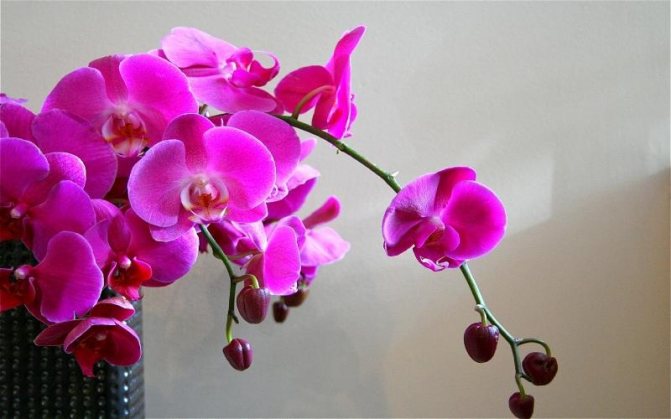

Epin for open ground - interaction with other drugs
Epin is used with almost all acidic fungicides, pesticides, fertilizers. The exception is Bordeaux liquid - this is an alkaline substance with which Epin is not mixed.
The drug is used for all garden crops - tomatoes, cucumbers, melons, cabbage. Works especially well with legumes.


Important! The hazard class of the drug is the third. This means it is safe for beneficial insects that pollinate.
When spraying, the disintegration period of the substance must be taken into account - 2 weeks. It is not recommended to carry out processing more often. You should also follow the rule: use the ready-made solution on the same day. Store no more than two days in a cool, dark place.
Benefits of using
The use of Epin is highly effective.Comparing its action with organic substances, experts note the rapid achievement of the set goals for the drug:
- causes intensive growth (ripening 2-3 weeks earlier than usual);
- provokes abundant flowering;
- the plant becomes strong, hardy;
- self-defense is activated at all levels;
- increase in percentage of yield;
- seed germination twice as fast;
- spraying and feeding with Epin protects against damage to the green part and roots by parasites, infections, fungal spores.
As a fertilizer, an active metabolism and excretion of salts of heavy metals (other harmful compounds) became a bonus. The package is read as a positive: an ampoule with a content of 1 ml. It is intended to be used only in diluted form.
Pros and cons
Pay attention to dignity of Epin among analogues:
- On forums and blogs, novice gardeners ask the question: "Epin and Zircon, when to use what?" Zircon is made on the basis of echinacea, the main purpose of this fertilizer is to increase immunity from fungal, viral and bacterial infections.
- Before the spring planting of seedlings in separate containers, it must undergo a hardening procedure. For hardening from daily temperature drops (in March-April), creating "anti-stress" conditions for flowers, you need to choose only Epin-extra.
- It is difficult to say unequivocally which is better - Epin, Zircon, Ekoriz, Kornevin or other growth stimulants, it all depends on the time, conditions and purpose. For example, Zircon is indispensable in the summer heat, when the air temperature is high and additional air humidification and shading of indoor plants are required. But with the instability of night temperatures in early spring, autumn cold snaps, flowers, young shoots will be protected by Epin-extra.
- Provides plant survival to a greater extent than other drugs.
- The product affects growth processes - it perfectly stimulates the vegetation of branches and stems. Kornevin, in turn, is more focused on nutrition, development and strengthening of roots.
- The priority quality is a completely non-toxic drug (not dangerous for humans, pets).
Processing rules
After you have prepared the solution, you need to start processing all flowers and plants. If it is an open space, make sure you have access to water. If you use it at home, you need to prepare very carefully and be sure to arm yourself with rubber gloves. An overdose of the product can negatively affect the plants, so be careful.
Indoor flowers can be treated with a solution to stimulate germination, the formation of new shoots, as an anti-stress adaptogen and an immunity stimulator. For prevention, spraying can be carried out once a month, after stress, it is recommended to water the flowers every 3-4 days. In order to stimulate growth, processing is carried out in March and April, July or August, as well as in the middle of autumn.



